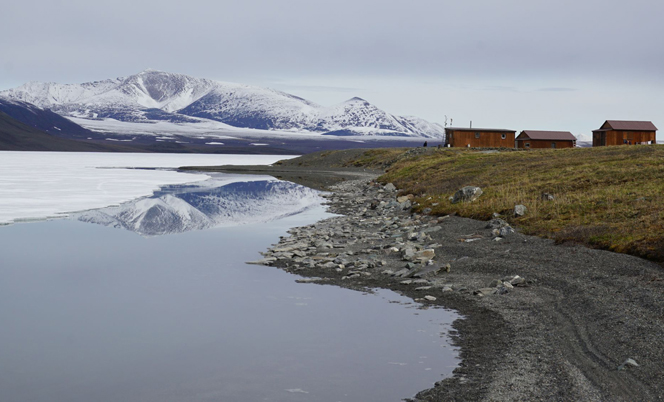To improve the accuracy of complex computer modeling, climate researchers in the Arctic are turning to natural features a little more in tune with longer time scales: glaciers and the lakes they feed.
The contrast between high-speed computing and slow-moving natural systems reflects the landscape of climate research in a region protected by its isolation, yet sensitive to change.

During the spring and summer of 2015, four successive groups of researchers and students from Northern Arizona University performed what they called “tag team” science at Lake Peters in the Arctic Wildlife Refuge. The multidisciplinary groups were gathering data for a $1 million, three-year National Science Foundation project funded by the NSF’s Arctic System Science Program.
“One thing the climate science community is working hard to understand is the challenging problem of how climate varies on time scales longer than what we can observe,” said Nick McKay, assistant professor at NAU and a member of the fourth research team. “We think climate models under-predict decadal to century-scale changes in climate.”
Sediment samples from Arctic lakes offer insights, and NAU Regents’ Professor Darrell Kaufman has been pursuing them for years. His research for the School of Earth Sciences and Environmental Sustainability has involved the collection and analysis of sediment cores for clues about climate and environment. But local, short-term variables introduced new questions.
“We realized we needed to do more groundwork to understand those complicated systems,” Kaufman said.
McKay said glacier-fed lakes are ideal targets for study because “glaciers are excellent recorders of long-term climate variability. Unlike living organisms, which have strategies to overcome changes in climate, glaciers don’t.”
But the catchment system involving a glacier and lake is also susceptible to changes in the watershed that cannot be explained solely by climate. So the teams set about to generate more data from Lake Peters in northern Alaska, then take the ambitious step of creating a data network with two other well-studied Arctic lakes, one in southern Alaska and the other on an island near Norway.
“We’re trying to combine field observations with models that simulate sediment transfer from the glaciated catchment to the lake,” Kaufman said. “If we can build the model, then we can turn knobs and ask questions about future outcomes.”
According to McKay, “No one has ever tried to do what we’re doing—simulate a whole watershed like this. Hopefully the model is good enough that we can ask some of our questions and get meaningful answers.”
While the work being done this fall consists mostly of analysis and modeling, the 
“Fieldwork in general is a roller coaster,” Kaufman said. “When conditions are good, there is no more beautiful place on earth. But when the mosquitoes are swarming or a storm is coming up, sometimes you want to be someplace else.”
After a winter of data analysis, teams will return to the site next summer for two more rounds of fieldwork. Kaufman said three students have joined the project this fall, including master’s degree students from geology and geography, and a Ph.D. student from the School of Earth Sciences and Environmental Sustainability. The school and the Department of Geography, Planning and Recreation provided the four lead investigators: Kaufman, McKay, Erik Schiefer and David Fortin.
Summer 2015 fieldwork participants included: Team 1–Kaufman, Fortin, Cody Routson, and Mindy Bell; Team 2–Fortin (continuing), Schiefer and Doug Steen; Team 3–Anna Liljedahl, Mike Loso, Maryann Ramos and Anne Gaedeke; Team 4–McKay, Fortin, Ethan Yackulic and Rebecca Ellerbroek.



